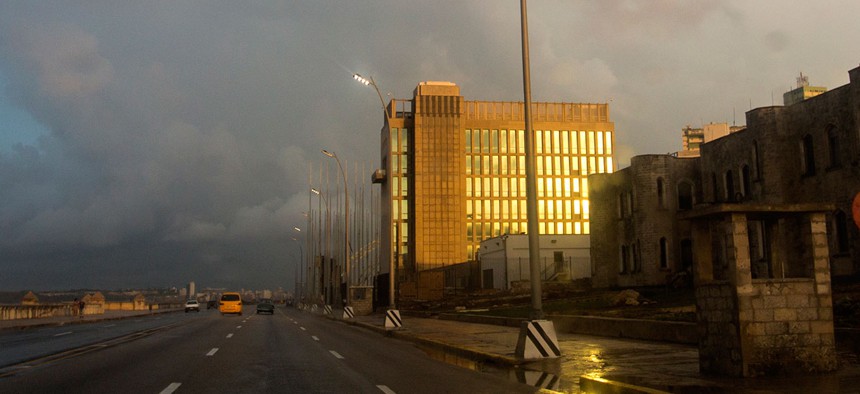
Rays from the setting sun shine on the facade of the United States Embassy, in Havana in October. Desmond Boylan/AP
The Case of the Sick Americans in Cuba Gets Stranger
The suspects include Cubans, Russians, cicadas, and psychology.
Toward the end of 2016, years into a slow rapprochement between the United States and Cuba, something strange started happening to CIA agents posing as diplomats in Havana.
This something may or may not have been a sonic attack. It may or may not have been deployed by Cubans, Russians, Venezuelans, or any other country with whom the United States has beef. A detailed new accounting of the affair appeared in ProPublica, the investigative news outlet, Wednesday. After talking with three dozen officials in different countries and looking at what were described as “confidential government documents,” the reporting confirms that no one has any idea what happened in Havana.
The facts of the case, so far as ProPublica has been able to suss out, are as follows: In November of 2016, an American official newly arrived in Havana with his family heard a strange, loud noise. Something like cicadas or insects, but really loud, and perhaps too “mechanical-sounding.” In December, a young man experienced the same thing—and began to suffer serious symptoms. These two people discussed their experiences of the sound in March. Shortly thereafter, the older diplomat and his wife began to receive medical attention for hearing loss and other problems.
In late March, the Americans in Cuba were finally told about what was happening to some of their colleagues. Word spread. Within a month, 80 Americans, including staff and family, wanted to be “checked out” by medical professionals. Word spread to the Canadians, too, and they got examined independently.
The older diplomat and his wife “along with 22 other Americans and eight Canadians ... would be diagnosed with a wide array of concussion-like symptoms, ranging from headaches and nausea to hearing loss.”
But note the difference in the number between the number of Americans checked out (80) and those diagnosed with symptoms (22).
Add to that: FBI investigators have found no evidence about what happened, despite being on the ground.
And finally: FBI officials have “privately emphasized the government‘s cooperation with its investigators,” according to ProPublica.
These are just three of the many things that have confounded investigators. Was there a real attack followed up with mass hysteria, once word started to spread? Or was it all mass hysteria? Or all attack? Or ... what?
The core problem is that no one has heard of or is willing to testify to the existence of this kind of acoustic weapon.
There are crowd-control weapons known by the euphemism “Long-Range Acoustic Devices” that are on the market and have been deployed against protesters at various times. But the way they would damage hearing is pretty obvious: They are really, really, really loud.
The facts of the Cuban case are very different. Some people report loud cicada-like noises. Others none at all. Some reported attacks in hotels, where other guests didn’t hear anything, so it would appear the radius of attack is quite small. A focused, long-range acoustic weapon is unknown to the world.
In 2007, Air Force researchers reviewed the research and literature on the topic and came to a solid conclusion. “Although high-intensity infrasound significantly disrupted animal behavior in some experiments, the generation of such energy in a volume large enough to be of practical use is unlikely because of basic physical principles,” they wrote. “On the basis of experimentation completed to date at a number of institutions, it seems unlikely that high-intensity acoustic energy in the audible, infrasonic, or low-frequency range can provide a device suitable for use as a nonlethal weapon.”
The AP has even released recordings of what it says diplomats heard, but that did nothing to further the case.
So, what the hell happened?
Bizarrely, the easiest explanation would be “mass sociogenic illness,” or what used to be called mass hysteria. There are dozens of examples in the extant literature, usually focusing on rumors of poison gases or, in more recent times, terrorist deployment of chemical weapons. The mind may be powerful, but sometimes, subsequent investigation reveals that there was some toxin causing the symptoms, after all.
Some Cuban scientists “have suggested that the Americans’ illnesses were psychosomatic.” But according to the State Department’s medical director, “No cause has been ruled out ... but the findings suggest this was not an episode of mass hysteria.” Physicians who were allowed to study the medical records of 21 of the affected people argued against the psychosomatic hypothesis in a paper in the Journal of the American Medical Association. “If you took any one of these patients and put them into a brain-injury clinic, and you didn’t know their background, you would think that they had a traumatic brain injury from being in a car accident or a blast in the military,” said Rachel Swanson, a coauthor on the study. “It’s like a concussion without a concussion.”
Perhaps the strangest theory that ProPublica explores is that the noise really wascicadas and that they did some damage. But Allen Sanborn, a biologist at Barry University, told ProPublica, “[A cicada] wouldn’t really hurt you unless it was shoved into your ear canal.”
And yet, despite no one being sure what happened, the mystery is now the linchpin of the American case to roll back the changes that the Obama administration made to warm up the relationship between the two countries.
The Trump administration, along with hardliners on Cuba like Senator Marco Rubio, are using the attack (or non-attack) as a pretext for cooling relations between the two countries. “There is no way that someone could carry out [this] number of attacks, with that kind of technology, without the Cubans knowing about it,” Senator Rubio told ProPublica. “They either did it, or they know who did it.”
But if no American team—CIA, State Department, or FBI—knows who did it, or if something even happened, what is reasonable to ask of the Cuban government?







